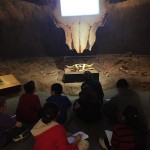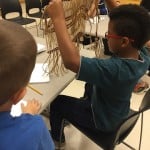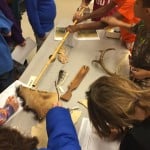

Today I’m going to tell you about a unit I worked on with 4th Graders that was designed to address the societies of Native American tribes and their influences on American culture and history. I am not going to focus on the steps we went through in the Guided Inquiry process as much as I am going to explain what worked and what didn’t work. As a reference point this unit was designed during a three day Guided Inquiry Design Institute by Kennedy’s Gifted and Talented Teacher and myself. Classroom teachers were not able to attend the institute due to scheduling constraints.
What Didn’t Work?
Obviously, the main obstacle for this unit was not having a teacher on the design team. Classroom teachers did provide a standard to work with and we knew they would willingly run with us as we dived into the process. As soon as we began planning the unit we realized how crucial at least one classroom teacher was to the development of this process. One, for their content knowledge. Two, for their understanding of where it would fall in the curriculum. Three, for the buy in they would be able to get from the other teachers on their team. The inability to have a teacher as part of the design process was a stumbling block throughout the unit, because we were never able to fully articulate the process well.
I would say the second obstacle to this unit was in large part me. You see, I tend to want to go all out with something and try everything to make the process smoother. For this unit that meant providing composition notebooks as a tool for student to keep their inquiry log/journal in and later rolling out a similar format via Google Docs while using Google Classroom. Students never really latched onto the electronic log/journal, so it wasn’t too big of a hindrance. However, in hindsight I see that it was something that was not needed. I also admit to not utilizing the journal effectively.
What Worked?
Partnership with the Gifted and Talented Teacher. My colleague and I did a lot of team teaching on this project, tag-team style. She was able to push into classes and teach how and what’s of the create stage. In addition, we teamed with teachers during the gather stage to help guide students along the way. She was a phenomenal asset and it was great for both of us to see how we could work together in the future.
Willing classroom teachers. Even though the classroom teachers were not able to attend the training or help plan the unit they were always willing to do what we asked. The teachers also provided ample opportunities for students to research and work on their products during the create stage. We could not have done this unit without their support.
Information Literacy Skills. Students were able to learn the proper way to cite sources during this project. They were able to learn how to “search smarter, not harder” using boolean operators. They were able to navigate EBSCO using the Explora database and found article were helpful for their research questions. Let’s be honest here folks, that is a difficult task for most of us and 4th graders were able to do that successfully multiple times. I often overlook how integrated information literacy skills were in this unit, but reflecting on all that students were able to do with them is one of the best things I am taking away from this unit.
Immerse. The immerse phase was my favorite part of this unit. As part of immerse we were able to visit the Sam Noble Museum of Natural History on the nearby University of Oklahoma campus. The GT teacher was able to acquire a grant to the museum so that we did not have to pay admission for any of our students or chaperones. This museum has an exhibit called the Hall of the People of Oklahoma that the sole focus of dovetailed superbly with our content standard.

We were able to download resources from the museum and have students paste them into their journals that they were able to keep notes on as they were guided through the exhibit. Students were also given journal prompts in the exhibit and given the chance to reflect as they explored the exhibit.
In addition to an exhibit students were led through a fifty minute class called, “The Bison Hunters: Native Americans of the Plains.” We had never been through a program at the museum and were skeptical of how this would go. We had nothing to be afraid of. During this program students were able to explore specific items in a group and tasked with identifying what they were made out of and what their possible uses were. Every student was engaged in this activity and they were all excited to see what their items were. Following the exploration time and comparing to identified materials the museum educator led the classes through what each item was and what it was used for. Students were able to create lists in their journals that they referenced during the rest of the process.

Student examining artifact.

Items identified by museum staff that students used to compare to their artifacts.
Google Classroom. Google Classroom was used to push artifacts and links to students during this unit. This was an effective way to get feedback from students as well. I used Google Classroom to provide templates, links and survey questions. Students completed surveys as an evaluative tool for their projects as well.
The extended learning team. The staff at the Sam Noble Museum knocked it out of the park in the classes that they taught. The exhibit was exactly what we needed to provide greater background knowledge for many of our students. Our district technology integration specialist, Dr. Lee Nelson also provided templates for students to use in the create phase. This help let the teaching team focus on helping students create from the template and not to worry about how to create the template.
Moving Forward
This post has been difficult for me to write because there are things that went exceptionally well with this unit, but there are many things that the team will improve upon when we implement this unit again in the future. At this time two teachers from the grade level have since been to a Guided Inquiry Design Institute so that will be extremely beneficial as we go back and identify what we need to change in this unit.
I am glad that the students and teaching team were able to go through this process. I’m glad that students were really forced to think and struggle with content in a new way and as a result create new knowledge from that struggle. I’m glad that I struggled with this process because it makes me look forward with instructional tools that I can use to make future units better. I’m glad that my GT teacher was able to such an integral role in the design and implementation of this unit because now she is my Guided Inquiry Design BFF. I’m glad that the classroom teachers from this team were able to see the process before they attended a GID Institute because they were able to make connections to what we did as they learned about the the process.
-Stacy
@StacyFord77
What a gift of a reflection, Stacy! I really appreciate your honesty about the difficulty of going to the institute without your teachers. It’s so important on so many levels that all the team members attend together. It builds capacity in your ability to collaborate and in knowledge about the design TOGETHER! Proud of you for keeping on with your BFF and bringing some of those teachers this time!
All these are great points to consider! Thank you!
I’m also so glad that your experience at the museum was so powerful. This is a component of Guided Inquiry that comes from Ann Caspari and it is a really unique aspect of what we are doing, and such a powerful way to learn that is often so underused. So glad you were able to take your unit to that level and that it was a part that you felt “worked!”
Leslie